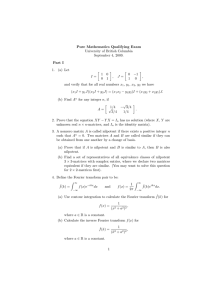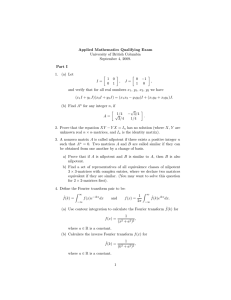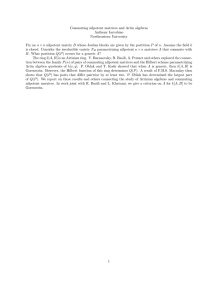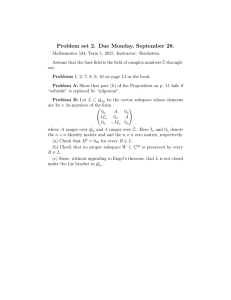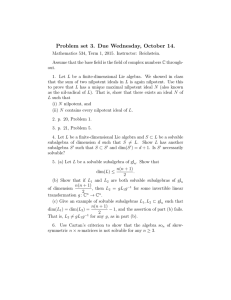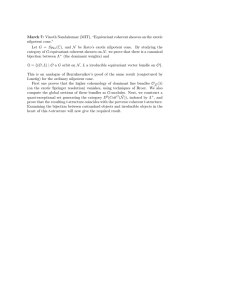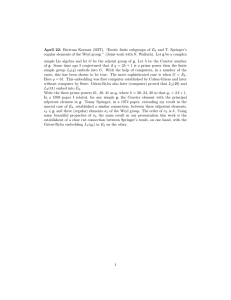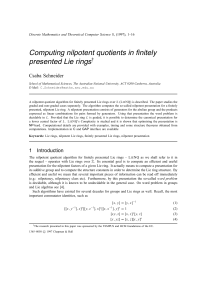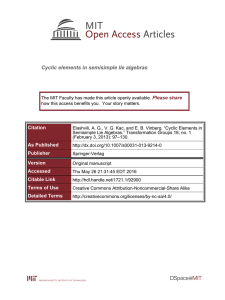Solutions to Problem Set 2
advertisement
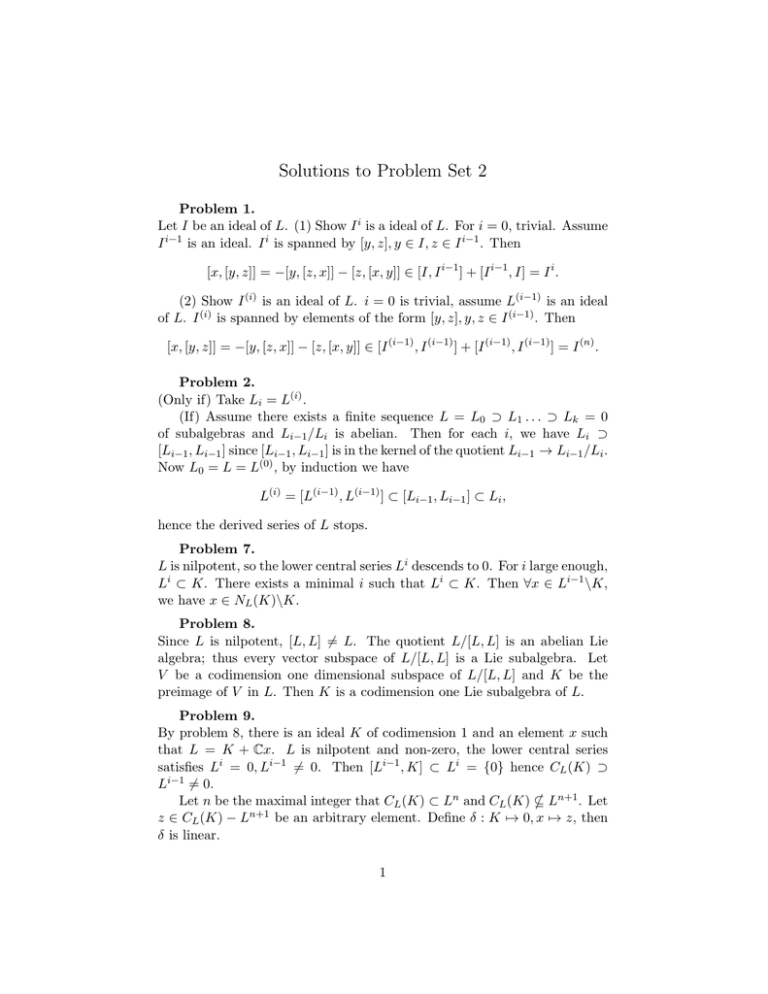
Solutions to Problem Set 2
Problem 1.
Let I be an ideal of L. (1) Show I i is a ideal of L. For i = 0, trivial. Assume
I i−1 is an ideal. I i is spanned by [y, z], y ∈ I, z ∈ I i−1 . Then
[x, [y, z]] = −[y, [z, x]] − [z, [x, y]] ∈ [I, I i−1 ] + [I i−1 , I] = I i .
(2) Show I (i) is an ideal of L. i = 0 is trivial, assume L(i−1) is an ideal
of L. I (i) is spanned by elements of the form [y, z], y, z ∈ I (i−1) . Then
[x, [y, z]] = −[y, [z, x]] − [z, [x, y]] ∈ [I (i−1) , I (i−1) ] + [I (i−1) , I (i−1) ] = I (n) .
Problem 2.
(Only if) Take Li = L(i) .
(If) Assume there exists a finite sequence L = L0 ⊃ L1 . . . ⊃ Lk = 0
of subalgebras and Li−1 /Li is abelian. Then for each i, we have Li ⊃
[Li−1 , Li−1 ] since [Li−1 , Li−1 ] is in the kernel of the quotient Li−1 → Li−1 /Li .
Now L0 = L = L(0) , by induction we have
L(i) = [L(i−1) , L(i−1) ] ⊂ [Li−1 , Li−1 ] ⊂ Li ,
hence the derived series of L stops.
Problem 7.
L is nilpotent, so the lower central series Li descends to 0. For i large enough,
Li ⊂ K. There exists a minimal i such that Li ⊂ K. Then ∀x ∈ Li−1 \K,
we have x ∈ NL (K)\K.
Problem 8.
Since L is nilpotent, [L, L] 6= L. The quotient L/[L, L] is an abelian Lie
algebra; thus every vector subspace of L/[L, L] is a Lie subalgebra. Let
V be a codimension one dimensional subspace of L/[L, L] and K be the
preimage of V in L. Then K is a codimension one Lie subalgebra of L.
Problem 9.
By problem 8, there is an ideal K of codimension 1 and an element x such
that L = K + Cx. L is nilpotent and non-zero, the lower central series
satisfies Li = 0, Li−1 6= 0. Then [Li−1 , K] ⊂ Li = {0} hence CL (K) ⊃
Li−1 6= 0.
Let n be the maximal integer that CL (K) ⊂ Ln and CL (K) * Ln+1 . Let
z ∈ CL (K) − Ln+1 be an arbitrary element. Define δ : K 7→ 0, x 7→ z, then
δ is linear.
1
Easy to check δ([a, b]) = 0 = [δ(a), b] + [a, δ(b)], ∀a, b ∈ L.
Finally, we claim that δ is outer. Indeed, assume the contrary: δ = ad(y),
then δ(K) = [y, K] = 0 and y ∈ CL (K) ⊂ Ln and [y, x] = z ∈ Ln+1 , a
contradiction.
Problem 10.
Only need to show ad(x) is nilpotent for all x ∈ L. L/K is nilpotent,
hence ad(x)|L/K is nilpotent, i.e. when m large enough, (ad(x))m : L → K,
now ad(x)|K is also nilpotent, when n large enough (ad(x)|K )n = 0, hence
(ad(x))m+n = 0 on L.
Problem A.
Take b to be the upper triangular Borel subalgebra of gl(n, C), n is the ideal
of b with diagonal entries zero. n is nilpotent, b/n is the diagonal algebra,
which is also nilpotent. But b is not nilpotent.
Problem B(b)
Assume
U is a nonzero common invariant subspace of all B ∈ L. Choose
v1
v = v2 ∈ U , where at least one vi ∈ Cn is nonzero.
v3
Case 1: v3 6= 0. Then ∀u ∈ Cn there exists a A ∈ gl(n, C) such that
Av3 = u. Then
n
0 In 0
v1
C
0 A 0
u
0 0 A 0 0 In v2 = 0 ∴ 0 ⊆ U.
0
0 0 0
0 0 0
0
v3
0
0
u
0
0
0
In
0 = u
0
0
∴ Cn ⊆ U.
0
0
0 −In 0
0
0
0 0
0
0
0
−In 0 0 u = 0 ∴ 0 ⊆ U.
0
In 0
0
u
Cn
Hence U = C3n . The only nonzero common invariant subspace is C3n .
Case 2: v1 6= 0. Then
2
0
0
0
v1
0
In
0
0 v2 = 0 ,
0 −In 0
v3
−v1
and Case 1 applies.
2
Case 3: v2 6= 0 but v1 = v3
0
0
In
0
0 −In
= 0 (otherwise reduce to case 1 or 2). Then
0
0
0
0 v2 = 0 ,
0
0
−v2
and, once again, Case 1 applies.
3
